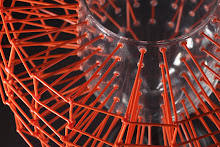“We all need to understand why we are here; why we exist and how we exist,” observes Jessica Julius, a Spring 2007 Resident Fellow at the Creative Glass Center of America. Yet her work suggests that although she finds this question endlessly intriguing, it is one to which she does not postulate or expect a definitive answer.
The idea of an evolving truth makes sense in the context of Julius’s on-going interest in science, especially physiology, an area of study which is never exhausted as each answer gives rise to new questions. In various ways within her work, Julius consistently juxtaposes the specificity of scientific observation with the mundane sometimes inchoate perceptions of lived experience. This disjuncture of perceptions is manifested in the silvery glass models of eyes to which she attached false eyelashes: silly yet rigorous and, yes, eyes in which we see distorted reflections of our own eyes.
Julius’ 2006 MFA from the Rochester Institute of Technology, followed up on studies of glass at Tyler and Pilchuck. At RIT she moved “beyond the limited vocabulary of just the material [glass]” to concentrate on photography, though mostly of glass. Perhaps not coincidentally, both fields can be expressive and are inevitably technically driven. Julius utilized glass with photography throughout her graduate exhibition “Static Synapse.” Some glass images were cast from the body, a technique which in this context functions as a primary layer of imprinting. She then photographed or printed the casts as photograms.
The mouth, Julius notes, can be “disgusting, beautiful and humorous,” qualities which make it a flexible, multi-faceted subject. She used a negative cast of her own as the basis of photograms. The witty, Clenched, a 5’ long repeating row of teeth cast in glass sandwiched between horizontal red lips, tells a story or perhaps half a dialogue.
Arbitrarily reorganized body fragments, illustrate Julius’ interest in morphological and physiological categories. Where does the finger end and the palm begin? In addition to differently organized categories, Julius is engaged by “rules about how things should look.” One of her installations in “Static Synapse” combined casts of “hybrid” fingers and parts of hands with site specific drawing. Photograms of these cast elements are labeled as if for scientific study.
Inspired by a sick cat, the “Spit Print Series,” combines her interest in the mouth with the observation of the ephemeral and of transformation over time. Julius drooled onto a sheet of glass and used the bubbly saliva as the basis of a photogram. The prints provocatively preserve and make beautiful something useless — even repulsive (once it’s left the mouth).
Julius recognizes an element of nostalgia in the most ambitious project she tackled during her CGCA fellowship. With it, she moves from the body as a subject to a focus on “how we experience things.” She made molds of old milk bottles from pastoral York, PA, in order to make new glass bottles in the same pattern. The original “artifacts that represent people and history” were made for the Julius Dairy, a well-documented business which belonged to her family. Her father has around fourteen different bottles from the dairy. Bottles from the Shepard Dairy are owned by a grandmother’s family; Julius may also reproduce those. She hopes to locate the factory where the bottles were made and incorporate this information somehow in an installation.
She will make at least one bronze mold into which she will blow as many as 1,000 bottles, probably in white glass. She may also cast them experimentally in other materials, but probably not at CGCA. The range of casts will include a negative bottle in a box. For one installation, she plans a yard-high pyramid of bottles, as they might have been once displayed.
The installation and narrative suggested by the bottles may be shown at the York Historical Society, but Julius also views the milk bottle as an extension of her on-going interest in morphology and taxonomy. She wants to think about containers and “how we contain things,” as a broader category
Relating to her family but in a more contemporary and personal way, Julius is experimenting with glass parachutes. Small and light, they will be functional, at least until they touch down. They are designed to “sacrifice themselves to protect the object” they carry. This project relates to Julius’ brother who is currently completing his third tour of duty in Iraq. “Every day has its emotional weight,” she says.
Julius sees her residency as an opportunity to experiment. “Since grad school I’ve wanted to say more. Now I can say ‘I feel like doing this so I’m going to.'"































